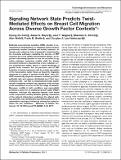Signaling network state predicts Twist-mediated effects on breast cell migration across diverse growth factor contexts
Author(s)
Kim, Hyung-Do; Meyer, Aaron Samuel; Wagner, Joel Patrick; Wells, Alan; Gertler, Frank; Hughes-Alford, Shannon Kay; Lauffenburger, Douglas A; ... Show more Show less
DownloadMol Cell Proteomics-2011-Kim-.pdf (2.336Mb)
PUBLISHER_POLICY
Publisher Policy
Article is made available in accordance with the publisher's policy and may be subject to US copyright law. Please refer to the publisher's site for terms of use.
Terms of use
Metadata
Show full item recordAbstract
Epithelial-mesenchymal transition (EMT), whether in developmental morphogenesis or malignant transformation, prominently involves modified cell motility behavior. Although major advances have transpired in understanding the molecular pathways regulating the process of EMT induction per se by certain environmental stimuli, an important outstanding question is how the activities of signaling pathways governing motility yield the diverse movement behaviors characteristic of pre-induction versus postinduction states across a broad landscape of growth factor contexts. For the particular case of EMT induction in human mammary cells by ectopic expression of the transcription factor Twist, we found the migration responses to a panel of growth factors (EGF, HRG, IGF, HGF) dramatically disparate between confluent pre-Twist epithelial cells and sparsely distributed post-Twist mesenchymal cells—but that a computational model quantitatively integrating multiple key signaling node activities could nonetheless account for this full range of behavior. Moreover, motility in both conditions was successfully predicted a priori for an additional growth factor (PDGF) treatment. Although this signaling network state model could comprehend motility behavior globally, modulation of the network interactions underlying the altered pathway activities was identified by ascertaining differences in quantitative topological influences among the nodes between the two conditions.
Date issued
2011-11Department
Massachusetts Institute of Technology. Department of Biological Engineering; Massachusetts Institute of Technology. Department of Biology; Koch Institute for Integrative Cancer Research at MITJournal
Molecular and Cellular Proteomics
Publisher
American Society of Biochemistry and Molecular Biology
Citation
Kim, H.-D. et al. “Signaling Network State Predicts Twist-Mediated Effects on Breast Cell Migration Across Diverse Growth Factor Contexts.” Molecular & Cellular Proteomics 10.11 (2011): M111.008433-M111.008433. © 2011 by The American Society for Biochemistry and Molecular Biology, Inc.
Version: Final published version
ISSN
1535-9476
1535-9484